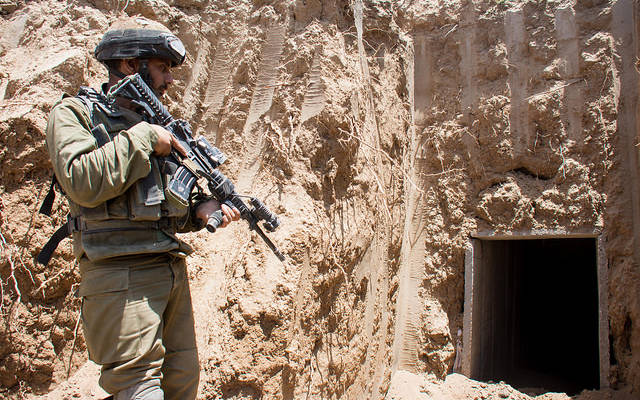The tunnel, which is described in a number of Israeli memoirs about the War of Independence, caved in before it could be used to annihilate the city’s Jewish population.
By Adi Hashmonai, Israel Hayom via JNS
Work to upgrade the entrance to Tzfat’s Old City (Safed) has unearthed an attack tunnel dating to Israel’s 1948 War of Independence. Experts believe that the tunnel was dug by local Arabs, who intended to use it to blow up the Ashtam Building, an old commercial structure that served as the important outpost and weapons stockpile protecting the city’s Jews.
At that time, Jews were in a small minority in Tzfat compared to the number of Arab residents in the city’s Muslim Quarter.
“This is the only attack tunnel we know of from the time of the War of Independence [other than the sewers used by the Haganah forces in Jerusalem], and also the first attack tunnel in the history of modern Israel,” said Nissan Sharifi, a researcher focusing on the history of the city.
A few years after the War of Independence, the ground near Ashtam Building was leveled to build a parking area for tourist buses bringing visitors to the old city. Workers refurbishing the area uncovered the tunnel and initially thought they had stumbled across an antiquity. They contacted the Israel Antiquities Authority, which began a rescue excavation, which turned up findings from the 16th century, the 19th century, a water cistern from the Ottoman period and the tunnel, which had been filled in at the end of the war and later paved over.
The IAA, as well as many Tzfat residents, were worried that the city would opt to re-cover the tunnel as part of its project to improve tourist facilities.
Binyamin Geiger, 96, who served as the commander of Tzfat during the war, said “if the Arabs had managed to blow up Ashtam Building, it would have ended us. The tunnel was the biggest strategic threat to the outpost, which was the most important one for our defense, and if it had fallen then, they would have gone into the Jewish Quarter and killed all the Jews.”
“It’s really exciting for me that they found it, and I’m very worried it will be covered up again. We have to preserve it for the sake of future generations,” he added.
The tunnel, which became almost a myth for Tzfat residents, was described in various books published by commanders, including Geiger, who served in the city during the war.
“One night, when I was patrolling, I was summoned urgently to the central position. The guy who was permanently stationed there, Mussa Sarur, told me excitedly, ‘Binyamin, listen to this, put your ear here on the earpiece, I can hear noise from the Arab market,’ ” Geiger wrote in his memoir.
“I listened closely. It was dark and shots could be heard from every direction, all the time. Aside from the shots, I also heard a kind of noise, like a shovel digging, as if it came from far away,” wrote Geiger.
Geiger informed Haganah commander of the city Meir Meivar, who sent him to neutralize what he suspected was a tunnel to be used in an Arab attack.
When Geiger set out, the noise stopped, and only after Tzfat was liberated did the Israeli fighters discover the tunnel.
“Later, we were informed that the heavy rains of that winter had caused the ground above part of the tunnel to collapse,” wrote Meivar.
“The Arabs thought that we had discovered it, and were watching it, so they stopped digging. After the city was liberated, we discovered the tunnel, whose ceiling had caved in at a point about 10 meters [11 yards] from the Ashtam Building,” recalled Meivar.
In light of public pressure to preserve the tunnel, the Tzfat Municipality has frozen work at the site.
“The city sees great importance in developing tourism in the city. … After the discovery came to light, Mayor Shuki Ohana issued instructions to look into its significance, and to promote a plan to preserve it and turn it into a tourist attraction. From the moment it was discovered, the city hired architects, consultants and architects to carry out in-depth research and prepare a detailed plan. We will publish the findings when they are available,” the Tzfat Municipality announced in a statement.
This article first appeared in Israel Hayom.
